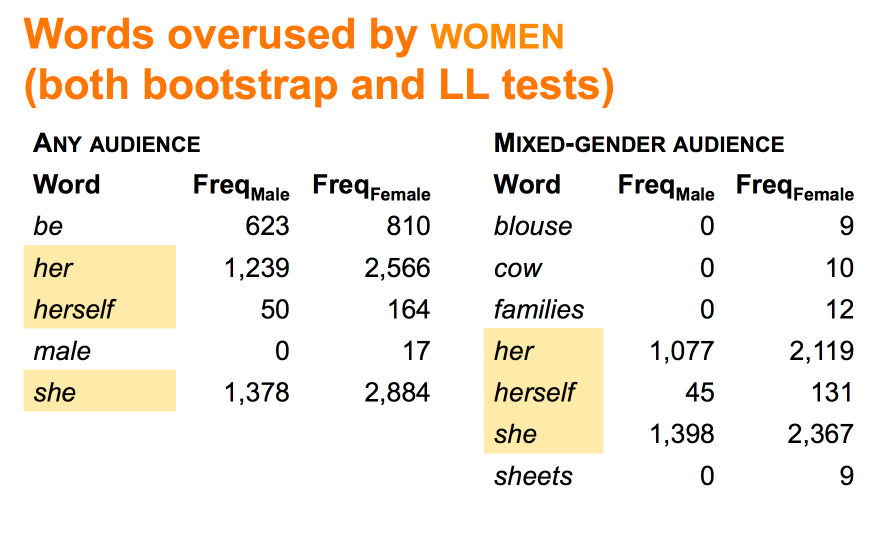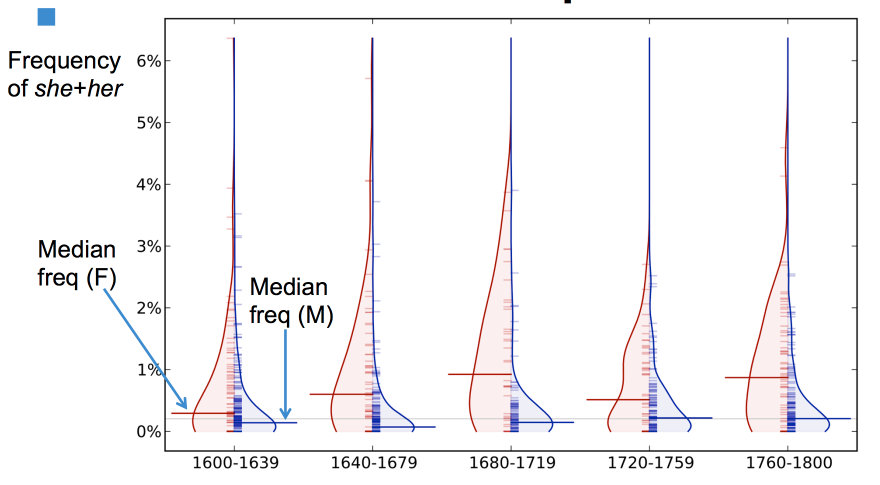400 years of referential inequality
« previous post | next post »
In "More fun with Facebook Pronouns", I noted that Facebook posts by males use masculine rather than feminine pronouns about 70% of the time, while female facebookers are much closer to a 50/50 split between masculine and feminine pronominal reference (48% masculine, to be exact). Tanja S. commented that
The discrepancy between male and female use of cross-sex pronouns is also present in the British National Corpus (1990s British English) and in the Corpora of Early English Correspondence (where we analysed English letters from 1600 to 1800).
She pointed to a figure from a presentation about the British National Corpus:
She observes that what the table calls women's overuse of feminine pronouns is actually men's underuse of them, and she references a figure from a presentation about the Corpora of Early English Correspondence that shows a similar difference in texts dated a few hundred years earlier:
Tanja also referred us to Shlomo Argamon et al., "Gender, genre, and writing style in formal written texts", 2003, which gives the following data for pronoun frequencies in non-fiction and fiction sections of the British National Corpus gives (frequencies in counts per 10,000, female/male ratios added by me):
| Pronouns | Definition | Genre | Median Frequency in Female Writers |
Median Frequency in Male Writers |
Female/Male Ratio |
|---|---|---|---|---|---|
| 3p-masc | he, him, his, himself |
non-fiction | 54.1 | 64.3 | 0.844 |
| 3p-fem | she, her, hers, herself |
non-fiction | 29.8 | 5.6 | 5.321 |
| 3p-masc | he, him, his, himself |
fiction | 276 | 305 | 0.905 |
| 3p-fem | she, her, hers, herself |
fiction | 392 | 128 | 3.063 |
This means that in the work of male non-fiction writers, 92% of animate third-person pronouns are masculine, while for female non-fiction writers, the proportion is 65%. In fiction, male writers' pronouns are 70% masculine, while female writers' pronouns are 41% masculine.
Comparable numbers from my calculations on the WWBP Facebook corpus are
| Pronouns | Definition | Genre | Frequency in posts by females |
Frequency in posts by males |
Female/Male Ratio |
|---|---|---|---|---|---|
| 3p-masc | he, him, his, himself |
38.5 | 45.7 | 0.842 | |
| 3p-fem | she, her, hers, herself |
42.2 | 20.0 | 2.11 |
To round out the collection, here are the numbers from the Fisher collections of conversational telephone speech:
| Pronouns | Definition | Source | Frequency in female speech |
Frequency in male speech |
Female/Male ratio |
|---|---|---|---|---|---|
| 3p-masc | he, him, his, himself |
Fisher | 60.5 | 45.8 | 1.321 |
| 3p-fem | she, her, hers, herself |
Fisher | 39.5 | 23.5 | 1.680 |
Thus in these conversational transcripts, the animate third-person pronouns used by male speakers are 66% masculine, while for female speakers, 60% of animate third-person pronouns are masculine.
In these transcribed conversations, we can split things up by the sex of the interlocutor, with the expected results. (The following numbers are from the Switchboard and Fisher datasets combined, based on counts of all animate — i.e. gendered — third-person singular pronouns.)
When men are talking with men, 69% of their pronouns are masculine; when men are talking with women, 63% of their pronouns are masculine.
When women are talking with men, 64% of their pronouns are masculine; when women are talking with women, 59% of their pronouns are masculine.


Vance Koven said,
September 28, 2014 @ 5:01 pm
Moral: you can take the boy out of the frat house…
Coby Lubliner said,
September 29, 2014 @ 8:59 am
Here is my hypothesis: in conversations about the private sphere, chances are that masculine and female pronouns are more less equally distributed. But in the public sphere, other than the world of entertainment — that is, politics, sports, religion and the like — the overwhelming majority of referents is likely to be male. And men's conversations tend to be more about the public than the private, compared to women's.
J. W. Brewer said,
September 29, 2014 @ 12:38 pm
I find it interesting that the magnitude of the effect is so much less in the telephone conversations. One thing that might be hard to measure adequately but would be interesting to know for any of these corpora is the rate at which "singular they" is being used as a third alternative to he/she (in all the various inflected forms) for singular animate antecedents and what sort of consequences more or less use of that alternative seems to have for the M:F ratio.
marie-lucie said,
September 29, 2014 @ 2:07 pm
Surely the choice of using he or she (and assorted variants) is not random, or dependent on the sex of the speaker: it depends on who is being talked about, not who is doing the talking. But there is also another source of lopsided use of he, the "default masculine" which uses the masculine pronoun as the generic. The phrase usually refers to the indefinite use, as in "one should always do his duty", a now older usage, especially in formal American writing, for which the spoken equivalent tends to be they and its variants. However, there is another notable instance of the generic use of he, in talking about animals, which (unless individually known, like the family pet) are usually referred to as he.
Keith M Ellis said,
September 30, 2014 @ 7:05 am
It's a man's world — women can't disregard men, but the reverse isn't true. So women's discourse roughly reflects the actual gender distribution while men's discourse is mostly about men. What's amazing to me is that this is news to anyone.